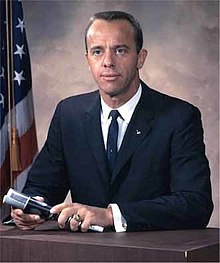Alan Shepard
| Alan B. Shepard Jr. | |
|---|---|
 |
|
| NASA astronaut | |
| Nationality | American |
| Status | Deceased |
| Born |
November 18, 1923 Derry, New Hampshire, U.S. |
| Died | July 21, 1998 (aged 74) Pebble Beach, California, U.S. |
|
Other names
|
Alan Bartlett Shepard Jr. |
|
Other occupation
|
Naval aviator, test pilot |
|
United States Naval Academy (B.S., 1944) Naval War College (M.A., 1957) |
|
| Rank |
|
|
Time in space
|
9d 00h 57m |
| Selection | 1959 NASA Group 1 |
|
Total EVAs
|
2 |
|
Total EVA time
|
9 hours 23 minutes |
| Missions | MR-3, Apollo 14 |
|
Mission insignia
|
|
| Retirement | August 1, 1974 |
| Awards |
Navy Distinguished Service Medal Distinguished Flying Cross Congressional Space Medal of Honor NASA Distinguished Service Medal (2) NASA Exceptional Service Medal |
Rear Admiral Alan Bartlett "Al" Shepard Jr. (November 18, 1923 – July 21, 1998) was an American naval officer and aviator, test pilot, one of the original NASA Mercury Seven astronauts, and businessman, who in May 1961 made the first manned Mercury flight. Shepard's craft entered space, but did not achieve orbit. He became the second person, and the first American, to travel into space, and the first person to manually control the orientation of his spacecraft.
Ten years later, at age 47 and the oldest astronaut in the program, Shepard commanded the Apollo 14 mission (1971), piloting the lander Antares to the most accurate landing of the Apollo missions. He became the fifth and oldest person to walk on the Moon, and the only one of the Mercury Seven to do so. During the mission, he hit two golf balls on the lunar surface.
These were his only two space flights, as his flight status was interrupted for five years during the Mercury and Gemini programs by Ménière's disease, an inner-ear disease that was surgically corrected before his Moon flight. Shepard served as Chief of the Astronaut Office from November 1963 to July 1969 (the approximate period of his grounding), and from June 1971 to August 1, 1974 (from his last flight to his retirement). He was promoted to rear admiral on August 25, 1971, the first astronaut to reach that rank. He retired from the United States Navy and NASA in 1974.
...
Wikipedia
